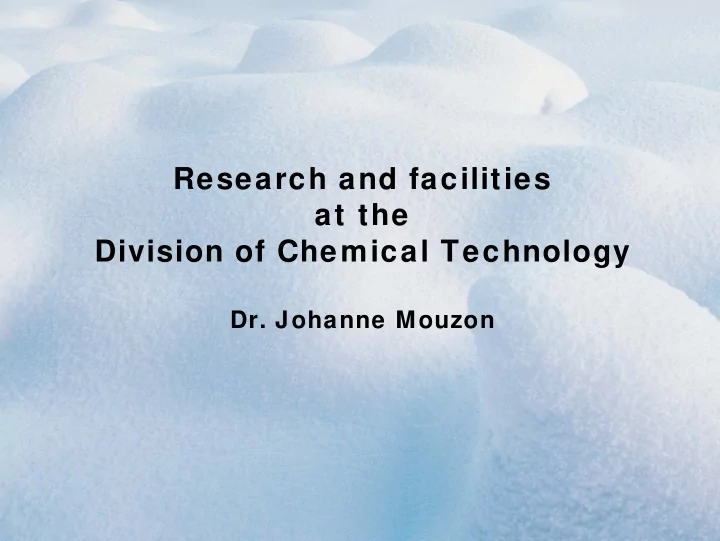

Research and facilities at the Division of Chemical Technology Dr. Johanne Mouzon
Research and facilities at the Division of Chemical Technology I. The Division of Chemical Technology II. Research fields 2.1. Zeolite membranes and related applications 2.2. Adsorbents and adsorption studies 2.3. Materials characterization III. Facilities 3.1. Relevant facilities for materials synthesis and characterization 3.2. Electron microscopy
Research and facilities at the Division of Chemical Technology I. The Division of Chemical Technology
Division of Chemical Technology at Luleå University of Technology Personnel Staff Graduate students Prof. J. Hedlund J. Lindmark (Zeolite membranes) Dr. J. Mouzon A. Mosca (Zeolite adsorbents) Dr. M. Grahn I. Carabante (Iron oxide) Mr. O. Niemi L. Sandström (Zeolite membranes) E. Potapova (Iron oxide) I. Uddin (Iron oxide) D. Korelskiy (Zeolite membranes) C. Häggström (Methanol synthesis) G. Garcia (Zeolite synthesis and membranes) W. Aguilar (Zeolite synthesis and membranes) Soon → Division of Chemical Engineering From January 1 st , merging as a superdivision together with the Divisions of: • Chemistry • Biochemical and Chemical Process Engineering.
Research Focused on materials development • Synthetic particles of inorganic crystals • Growth of thin films by wet chemical methods • Characterization of the synthesized materials Applications • Membranes Current sponsors • Catalysts • VR (Swedish research council) • Sensors • STEM (Swedish Energy Agency) • Adsorbents • FORMAS • Iron oxide agglomerates • HLRC • Vinnova Partners • LKAB • Stockholms Universitet • Boliden • Chalmers and KTH • Sida • Monash University Australia • Ångpanneföreningen • LKAB • ETC
Research and facilities at the Division of Chemical Technology II. Research fields
2.1. Zeolite membranes and related applications Zeolites : aluminosilicate materials with pores ranging from 0.3-1.3 nm ⇒ Molecular sieves Oxygen Silicon or aluminum The MFI structure Separation mechanisms in zeolite membranes:
2.1. Zeolite membranes and related applications Silicalite-1 membranes Hedlund et al. Microporous and Mesoporous Mater. 52 (2002) 179. 500 nm-thick membrane ⇒ very high degree of throughput
2.1. Zeolite membranes and related applications Applications in environmental separation processes and biofuels synthesis: • carbon dioxide removal: separation of CO 2 from synthesis gas • biofuel separation: separation of methanol from synthesis gas or butanol from fermentation broth. • catalytic synthesis of methanol/DME via black liquor gasification Synthesis of zeolite membranes from Bolivian clays.
2.2. Adsorbents and adsorption studies Activities: • Development of new structured adsorbents • Adsorption studies by FTIR-ATR for different applications Based on two types of materials: • Zeolites • Iron oxides
2.2. Adsorbents and adsorption studies Zeolite-coated honeycombs: a new class of CO 2 -adsorbents, low pressure drop alternative to zeolite beads for pressure swing adsorption (PSA) Traditional adsorbents in the form of beads Structured adsorbent in the form of film of Mosca et al. manuscript. monolith with parallel channels
2.2. Adsorbents and adsorption studies Fourier transform infrared attenuated total reflectance spectroscopy (FTIR-ATR) is used to study adsorption of: • ethyl benzene on zeolite (sensor application) • flotation agents on iron oxides (iron ore mining application) • arsenates on iron oxides (environmental application) Film to be studied IR beam is totally reflected along the sample in the ZnSe ATR crystal ⇒ the film is probed by the IR beam.
2.2. Adsorbents and adsorption studies • Examples on iron oxides: flotation agents on hematite Cross-section view of the hematite film ATR crystals before (a) and after (b) coating obtained by multiple-step dip-coating arsenates on goethite Goethite film on ATR crystal Top view of the goethite film
2.3. Materials characterization Distribution of porosity and binder in wet/dry iron ore pellets Presence of large air bubbles in wet ⇒ samples (frozen) Bentonite bridging two iron ore particles after drying ⇓
2.3. Materials characterization Fe O EDX mapping (preliminary) Si
Research and facilities at the Division of Chemical Technology III. Facilities
3.1. Relevant facilities for materials synthesis and characterization Synthesis: • Autoclaves • Spin- and dip-coaters • Freeze-dryer Characterization: • SEM, Scanning Electron Microscope • EDX, Energy Dispersive X-ray Sprectroscopy • Powder X-ray diffraction • Analyzer of adsorption isotherms (BET specific surface area) • Particle size and zeta potential measurements by laser scattering
3.2. Electron microscopy New high resolution scanning electron microscope: • Field emission gun • Analytical equipments: EDX, STEM, CL, EBSD? • Mineral liberation software Electron microprobe for : • quantitative elemental analysis based on WDX spectroscopy
That w as all! Thanks for your attention! Questions?
Recommend
More recommend